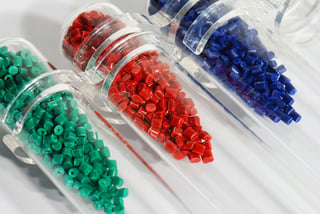Injection molding is the processing method used in 75% of the plastics industry. It is used to convert raw plastic to useful shapes for all types of industries including the automobile industry. Although there is a substantial upfront investment, injection molding is beneficial because the cost is low after the initial investment.
You may be asking yourself, “why is injection molding such a popular processing method?” There is a good dimensional control of product, more complex part geometry compared to other processes, a repeatable quality of production, and large production volumes are possible.
We are able to use a wide range of polymers with injection molding, and these polymers have the desired properties for the particular application. Most thermoplastic materials have the ability of being re-shaped numerous times when heat is applied. A polymer’s properties are determined by the molecular structure and type, both influencing how closely the molecular chains can be packed.

The molds have several qualities which include working as a heat exchanger, withstanding substantial clamping and injection pressures, provides ejection mechanism, and delivers melt to cavities.
The injection molding machine must melt plastic and force it into the mold which is clamped shut by the machine also. It is equipped with process controls and monitors to ensure repeatability. There is auxilliary equipment for regulating mold temperature and handling production and waste.
There is a seven-step process to injection molding:
- Raw plastic is fed into the flights of a screw surrounded by a heated barrel.
- The plastic is melted as it is forced through the barrel by the turning of the screw through frictional heat of the screw turning and convectional heat absorbed from the walls.
- The melted plastic is forced by a plunger into the mold which is held closed by a clamping unit.
- The melted plastic goes through a runner into the cavities to form the shape of the desired part.
- The plastic solidifies when it comes into contact with the relatively colder walls of the mold.
- After the parts are solid enough, the mold will open and parts are ejected from the machine.
- The cycle repeats with a new mold and new plastic.
Injection molding can be a complex subject to comprehend since it is a science. Skilled processors and mold makers are currently in high demand. At Pleasant Precision, Inc., we are proud of the strong reputation we have built for our injection molding with regard to our high precision and unique success partnering with our customers.


